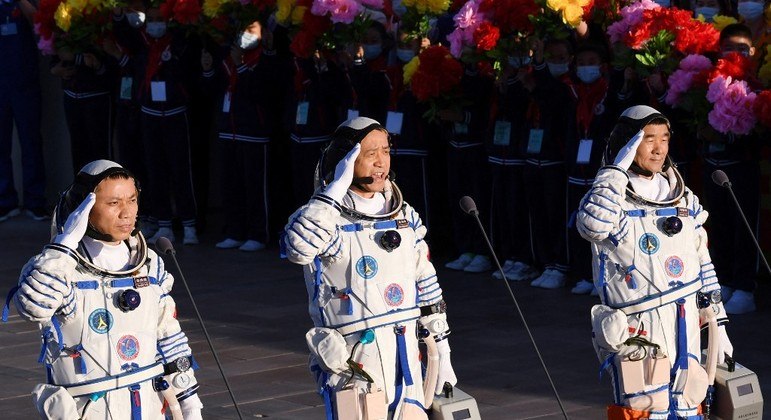Chinese astronauts safely return to Earth – News
3 min read
Three Chinese astronauts on Friday (17) returned to Earth after a record three-month period aboard the Chinese space station, which is under construction.
The mission marked a milestone for the Asian nation in its ambitious space exploration programme.
With the help of parachutes, the capsule landed Friday at 1:34 pm (2:34 am GMT) in the Gobi Desert, northwest of the country, according to the China Space Agency (CMSA).
The three men took off on June 17 from the Jiuquan launch center near the landing point on Friday. The Shenzhou 12 mission was the longest in space in the country.
“It’s great to be back,” 45-year-old astronaut Tang Hongbo told state TV channel CCTV shortly after leaving the capsule.
“Dad, mom, you’re back! I’m healthy and in a good mood,” Hongbo added, while my older colleagues, Nie Haisheng and Liu Buming, looked even more tired.
Huang Weifen, a senior official with the space program, said the three had been placed in quarantine.
“The measure was taken to protect them, not because of the coronavirus, but because of their weakened immunity due to their long stay in space,” said Wivine.
CMSA celebrated the “complete success” of the mission, which marks a new stage in China’s ambitious space programme, which already has probes on the Moon and Mars and plans to send astronauts to the Moon by 2030.
“The Shenzhou 12 mission achieved the goal of getting the new station up and running,” Jonathan McDowell, an astronomer at the Harvard-Smithsonian Center for Astrophysics in the United States, told AFP.
“This paves the way for future regular missions to the station. It was very important and really crucial to achieve success in the beginning,” said Chen Lan, an analyst at GoTaikonauts.com who specializes in China’s space program.
Surveillance cameras showed the three men returning live, complete with images from a camera aboard the capsule that showed the flight at great speed over the desert.
Aboard Tianhe (“Heavenly Harmony”), the only one of the three space station modules already in space, astronauts Ni Haisheng, Liu Beoming and Tang Hongbo performed many missions.
The crew carried out several spaceflights, maintenance operations and also installed equipment to operate the space station, the first of which was launched in April.
Once completed, the Tiangong station (“Heavenly Palace” in Portuguese) will be similar in size to the former Soviet Mir station (1986-2001) and should have a useful life of at least ten years, according to China’s space agency.
China’s ambition to build a station was motivated by the United States’ refusal to grant the country access to the International Space Station (ISS), a collaboration between the United States, Russia, Canada, Europe and Japan.
Shenzhou-12 is the first Chinese mission in nearly five years and a matter of prestige for the Communist Party, which celebrates its centenary this year.
But are the Chinese on the same level as the Americans?
“Although China is way ahead of Europe in terms of human spaceflight, there are still gaps with regard to the United States, and it will take more than a decade, or even more, to overcome them,” says Chen Lan.
It points to the United States’ advantage in technology and even cost savings, with the current use of reusable launch pads to reach the International Space Station.
“But the main American advance lies in experience,” McDowell notes.
“Chinese astronauts, for example, made (during this mission) two space exits,” says Chen Lan. “It’s far from the hundreds that happen with the International Space Station. That number makes the difference.”
The Shenzhou 12 mission was the third of 11 that will be required to build the space station between 2021 and 2022.
Officials said the next launch of the Tianzhou-3 spacecraft, which will carry only equipment, will take place in the next few days. Specialized sites claim that it will take place on Monday.

“Musicaholic. Thinker. Extreme travel trailblazer. Communicator. Total creator. Twitter enthusiast.”







